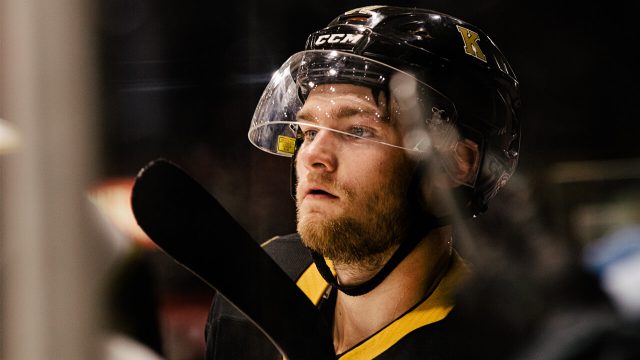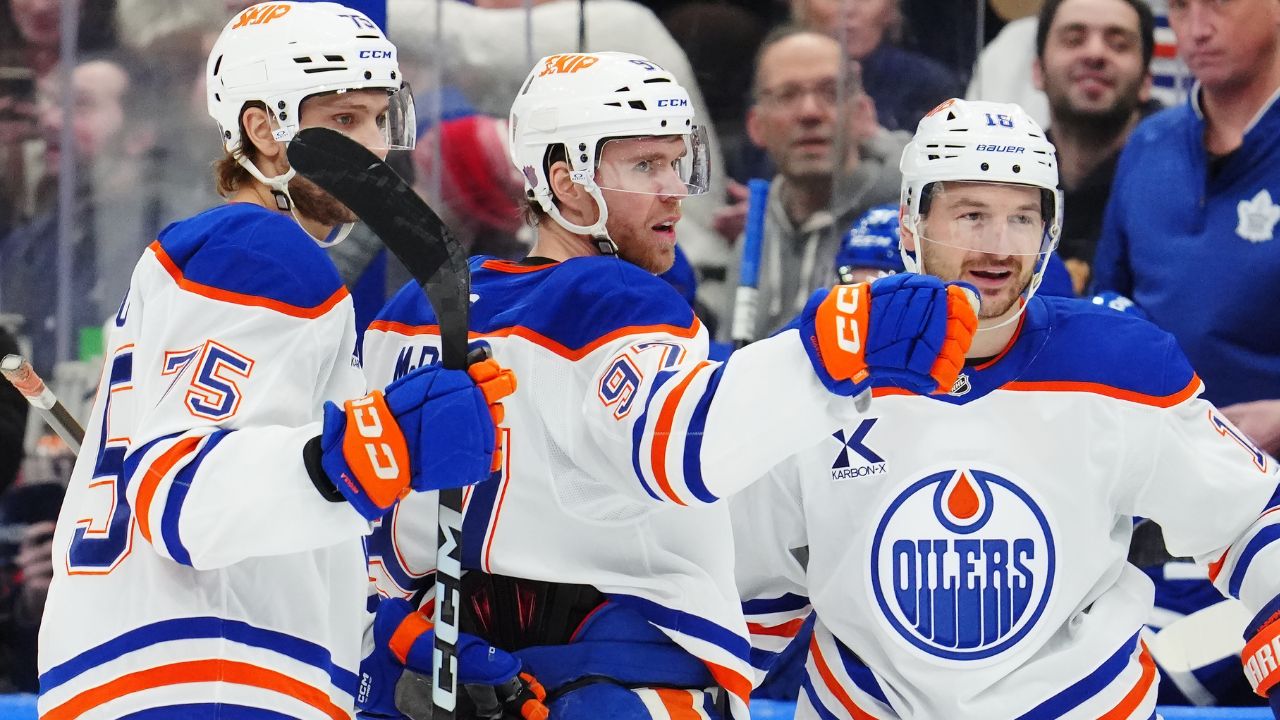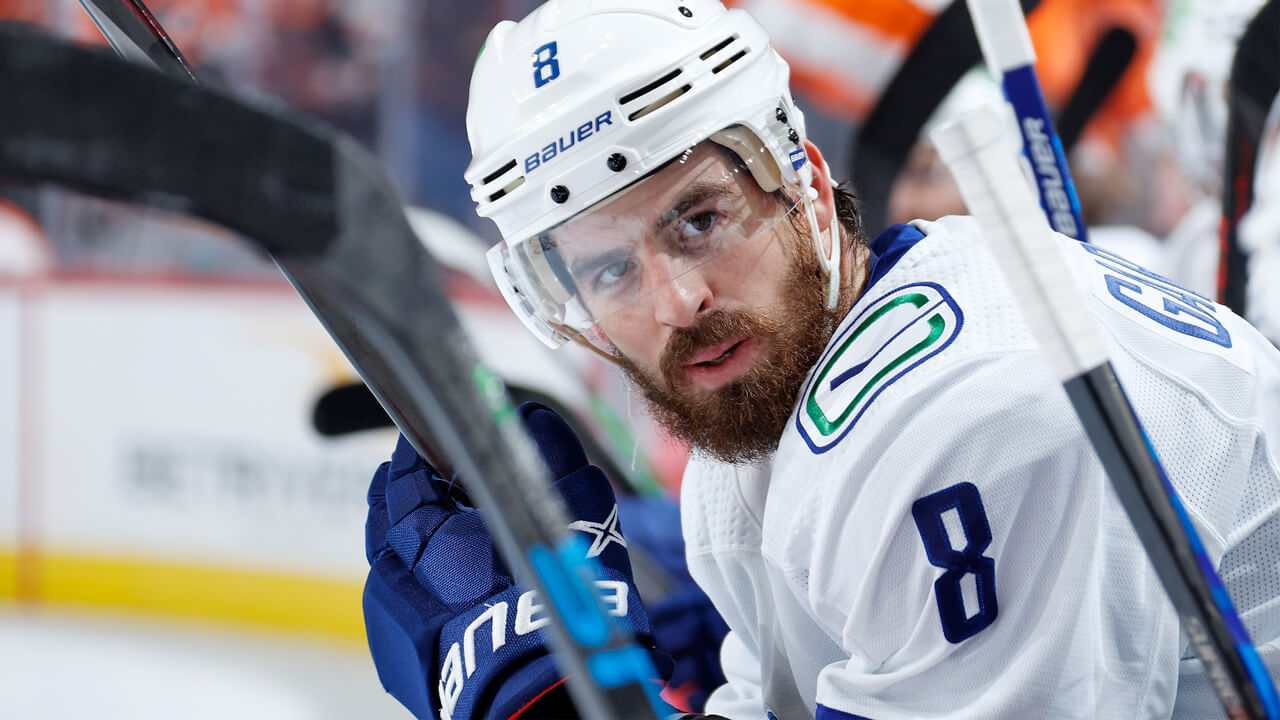
KILLER INSTINCT
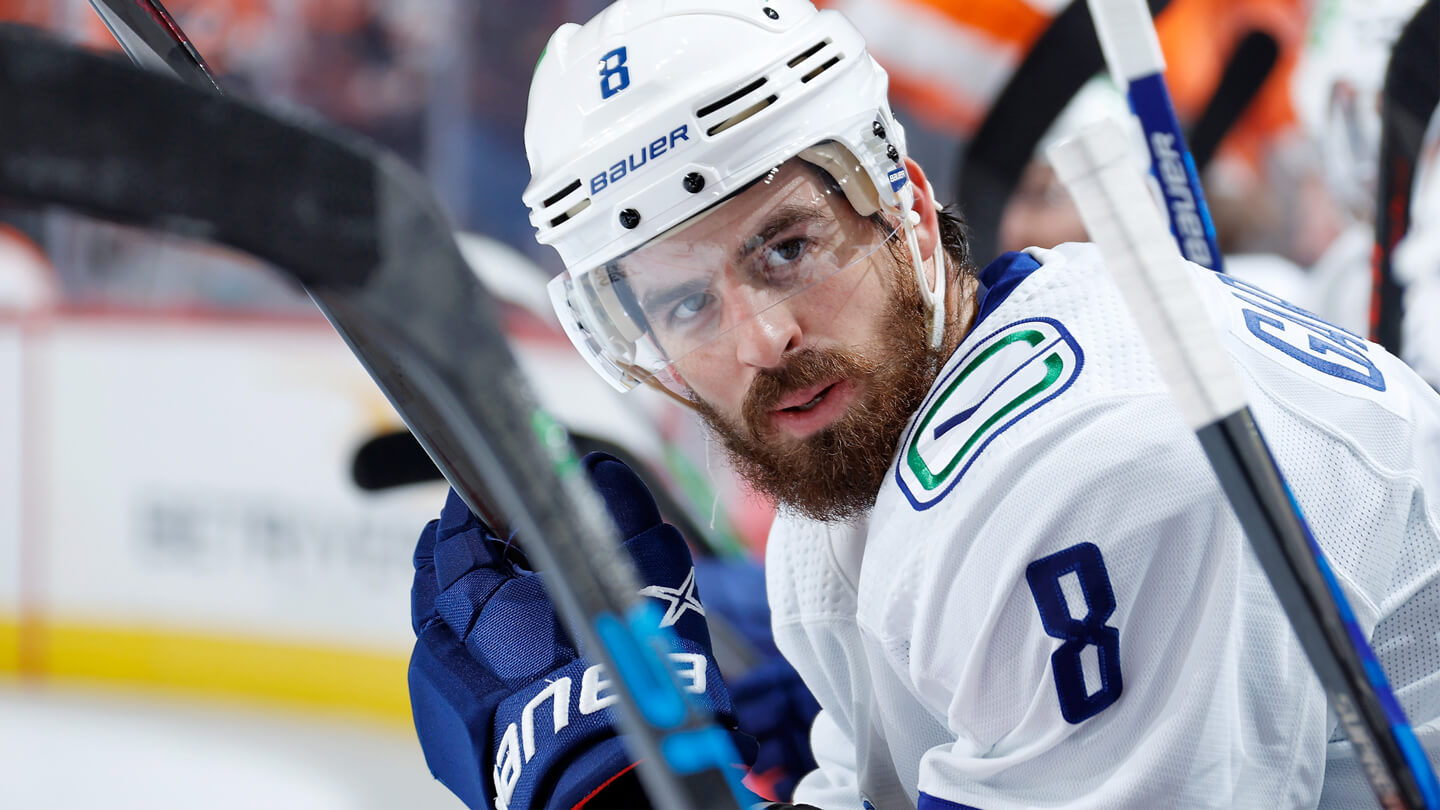
O
nly two things occupy more space in Conor Garland’s mind than hockey: an undying dedication to all things Boston sports, and sharks.
It’s early October, and clad in his customary post-practice threads — a navy Adidas windbreaker and matching Vancouver Canucks cap, its green brim pulled low — Garland’s eyes light up when rumours of his obsession with the creatures are raised. “I love sharks,” he says, a wide smile breaking through his scruffy beard, escalating quickly into a chuckle. “I grew up on the ocean — I actually don’t swim in the ocean, because I know that they’re closer than people think. I don’t know, I just love sharks.”
Garland’s been a shark-head as long as he can remember, since he was a kid on the South Shore, an hour southeast of Boston, collecting them as stuffed animals before eventually graduating to figurines. Teammates from those younger days offer a knowing laugh when the subject’s broached, and lament the number of discussions they’ve had with Garland about his favourite film (Jaws, obviously). “He’s never seen a shark in person in his life, which is the funniest thing,” says Seattle Kraken winger Ryan Donato, who grew up down the street from Garland and remains a close friend. “I go fishing all the time and I invite him out with me, and he’s like too afraid to see a shark in real life. But he’s completely fascinated by them.”
No one understands the depth of Garland’s marine love better than Cam Askew. A fellow Massachusetts native, he and Garland became best pals during their run as linemates for the QMJHL’s Moncton Wildcats. Sitting next to each other on the team bus for three years, Askew would routinely pull up photos of random sharks on his phone during daily rides, putting Garland’s knowledge to the test.
“He would just show me a picture and be like, ‘What kind?’ And listen, I can get it,” says Garland, beaming with pride. “Nine out of 10 times, I can get it — or, like, a relative of it.”
Watch Garland man the right wing for the Canucks, and the obsession makes a strange kind of sense. Whether during his time in the big leagues, his dominant run in junior hockey, or any of the teams he suited up for prior, one thing’s long been true of Garland’s game: he doesn’t float or meander. He doesn’t hesitate. He’s a shark in the water, fearless and intentional in his approach to the game — and in his faith in his abilities. “Conor’s a guy that sticks to his guns,” Donato says. “I mean, he liked sharks as a kid and he likes sharks as an adult. … Whatever he really feels or believes, he’s kind of stubborn in the way he thinks [about it], whether it’s watching one movie, Jaws, or opinions about anything. It’s just the way he is.”
If not for that stubbornness translating into a steadfast belief in himself, Garland might’ve never made it to this point. Turned away by team after team in high school, told he was too small to play more times than he can count, buried on the fourth line when he finally began his pro career, he’s been doubted at every turn. Now, after clawing his way to the big leagues and fighting to become an everyday NHLer, Garland finds himself against the ropes again. His Canucks have dug themselves a deep hole, allowed the doubts to stockpile, their early struggles prompting ownership to clean house above them. But Garland’s been here before. And as his team begins to navigate its way out of the dark, the fiery winger is emerging as a leader by doing what he’s done his entire career.
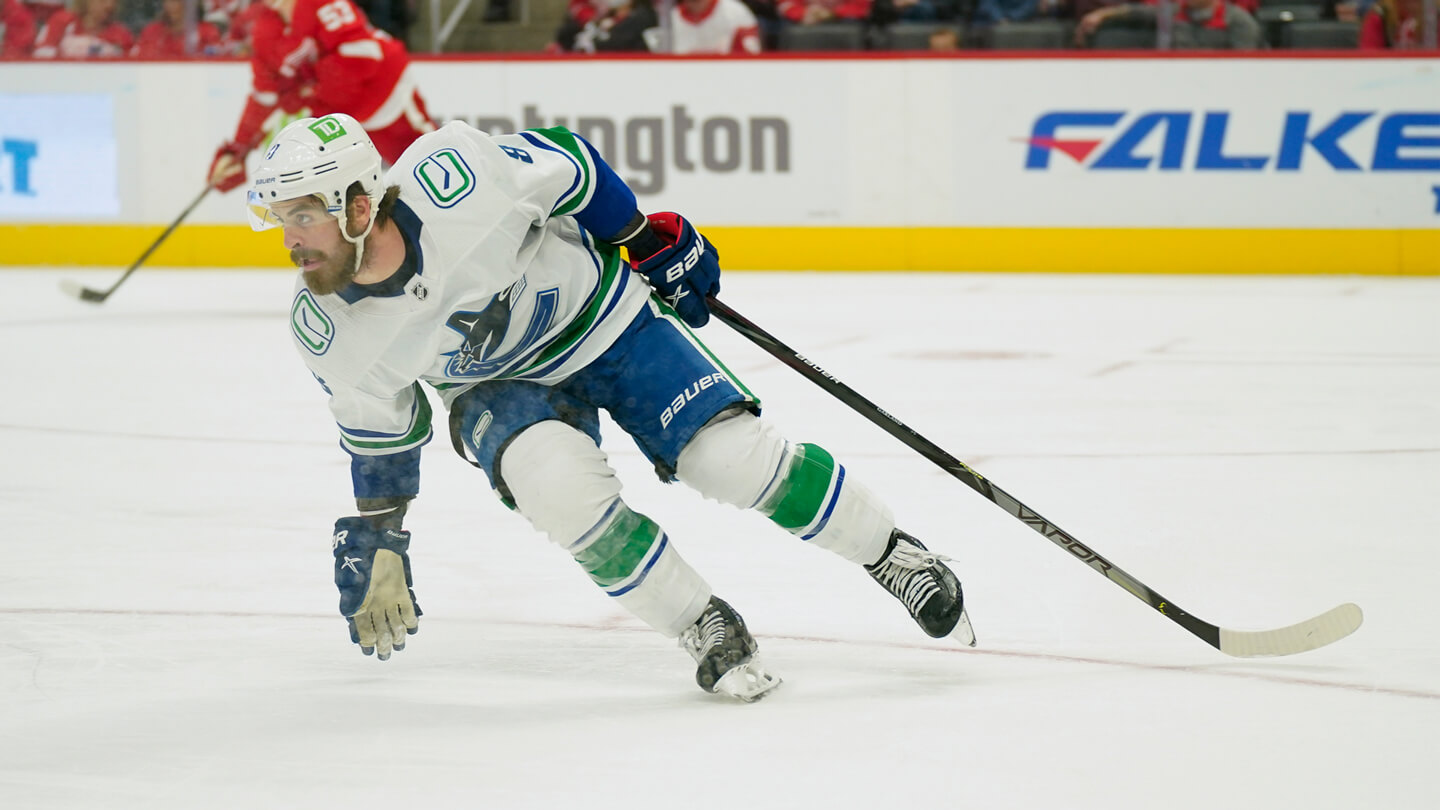
O
ne of the earliest memories Garland can recall is a hockey memory. He was five years old, back in his hometown of Scituate, Mass., when his dad, Garry, woke him up at five in the morning saying something about a surprise in the backyard. Making the sleepy trek outside, Garland came upon a frozen rink, painted with red and blue lines just like the ones he marvelled at on TV. Garry revealed a row of letters painted into the ice spelling out his son’s name, and at the centre of the sheet, the spoked ‘B’ of his favourite NHL club. Even with school a few hours away, there was no stopping a young Garland from grabbing his skates and going for a spin.
“I loved it right from the start,” he says of the sport. Moments like that one played a key role in why. “My dad played in the minors for a little bit. He played growing up and made it on his own … [so]he wanted to give me every opportunity to be successful, opportunities he wasn’t presented with.”
It didn’t take long before the impact of those opportunities started showing up on the ice. “Without sounding, you know, arrogant or bragging, when I was eight or nine I remember saying to my dad, ‘It’s weird, I’ve never not scored in a game. I’ve never played a game without scoring a goal,’” Garland says. “I remember him telling me, ‘Yeah, that’s not normal.’” But as quickly as Garland excelled past the other young skaters in his town in those early years, reality pulled him right back when he was around 12 years old. The kids he was going up against started coming back every season taller, sturdier, while Garland’s growth plateaued. “I was almost a foot smaller than some guys, and close to 80 pounds lighter. Then I struggled a lot,” he remembers. “But, you know, I think having that confidence … that belief, it got me through those years.”
The further Garland travelled on the path toward his big-league dream, the more obstacles were dropped in his way. Leaving Massachusetts in 2010 for Shattuck-St. Mary’s, the famed Minnesota boarding school that helped mold NHL stars like Sidney Crosby and Nathan MacKinnon, 14-year-old Garland was passed over for the school’s top team, relegated to the Tier 2 squad. Before he had a chance to go back and vie for a top spot, he had to leave Shattuck altogether. “My mom got sick that summer,” he says. “She had Lyme disease and it led to a small stroke and Bell’s palsy, so she was sick for a couple of years. It was at the point where I couldn’t be cross country. I had to be home with my family.”
His mother, Bridget, thankfully recovered, he says, but back then, the situation was a lot to bear for a teenager far from home. And amid the turmoil of leaving school, heading back to Scituate, and worrying about his family, Garland had another wrinkle to sort out: he needed a team. “I came home and didn’t really have a place to play,” he says. And despite dominating his lone year at Shattuck to the tune of 65 goals and 116 points in 52 games, the Boston high-school circuit seemed uninterested in his talents. “I was asking teams to play. I tried to go to B.C. High [Boston College High School] and the coach didn’t think I could play there. And then at Thayer [Academy], Tony Amonte didn’t think I could play there.” Only one coach didn’t turn him away — Boston Junior Bruins bench boss Chris Masters. So that’s where Garland went. “I think having that rejection at a young age and having people to prove wrong at such a young age usually doesn’t happen for NHL players,” Garland says. “Usually they have it easy until they start to get to the pros and then they have a little bit of a struggle. But that was almost better for me, just to have it at a young age and then have a chip on my shoulder.”
Masters didn’t need much convincing to toss a jersey Garland’s way. He’d had him on a summer team as a six-year-old, and knew what the young winger could do with the puck on his stick. More than just Garland’s raw skill back then, it was how he’d fared compared to the others on that summer squad that most impressed Masters, that team dotted with future superstars like Jack Eichel and William Nylander. Despite that lofty competition, Garland still managed to separate himself from the pack. “He was a standout on a team of standouts,” Masters says.
When the two reunited in 2011 for the Junior Bruins, it was much the same, even with Eichel returning to the squad as well. “He was a top player from the very first practice,” Masters says of Garland. “He was a great skater, [had]great speed, quickness, anticipation. He was really smart offensively, had a scorer’s touch, but also was really creative.” But there was something distinct that separated Garland from the other high-flying scorers in the area at the time. “He’s also a kid who has no fear,” says Masters. “He would go across the middle. He’d go to the net. He would go into corners. He wouldn’t take the long way to get to a corner or to a puck.” That was no small feat given how exaggerated the size discrepancy between Garland and his opponents was at that point. But he learned to bob and weave around that obstacle like he had all the others. “He was tough to track down,” says Masters. “He was small, and he was playing against kids who were 18, 19, in some cases 20. And he’s probably a pretty frustrating kid to play against — he can make you look silly. But you can’t hit what you can’t catch.”
Gifted, driven and fueled by years of stockpiling doubts, Garland was already a handful. But on the Junior Bruins he found something he hadn’t in Minnesota, something that pushed him to an even higher level: the chance to skate alongside someone who could see the game as he could. “We made each other better,” he says of leading that team alongside future second-overall pick Eichel. “You could feel in practice — I wanted to show that I was the best; he wanted to show that he was the best. In games, he wanted to produce, I wanted to produce. … We just pushed each other. It was great to have somebody like that at such a young age.” Likely less enjoyable for the rest of the Empire Junior Hockey League — the pair led those Junior Bruins through the season easily, dropping only six of their 40 games, Garland pacing the team in goals, assists and penalty minutes.
There’s one particular game that stands out among the rest for Masters, one night that encapsulated who Garland was at that time. “It was a game at Bridgewater, which is down on the South Shore where he was from,” the coach says. “We were a top team in the league, the team we were playing was kind of middle of the pack. He wasn’t having his best game, taking some bad penalties, cheating it a little bit in the defensive zone.” So Masters turned to a tried-and-true coaching tactic — “I sat him for about 10 minutes.” Garland remembers it well, too. “When you’re that young and you get benched, you don’t pout but you’re just angry,” he says. “Back then, I probably didn’t understand it. So, I was just angry.” Chip on shoulder activated.
“After that 10 minutes,” Masters continues, “I said, ‘Hey, you understand why you got sat?’
‘Yep.’
‘All right, let’s see if you’ve learned from it.’”
Garland hopped over the boards and the ice tilted. “In the third period, he scored a hat trick and we won the game by a goal,” Masters says with a laugh. “He had the right attitude, which was, ‘I understood it. I got it. Now I’m going to go out and do my thing.’ And he just took the game over.”
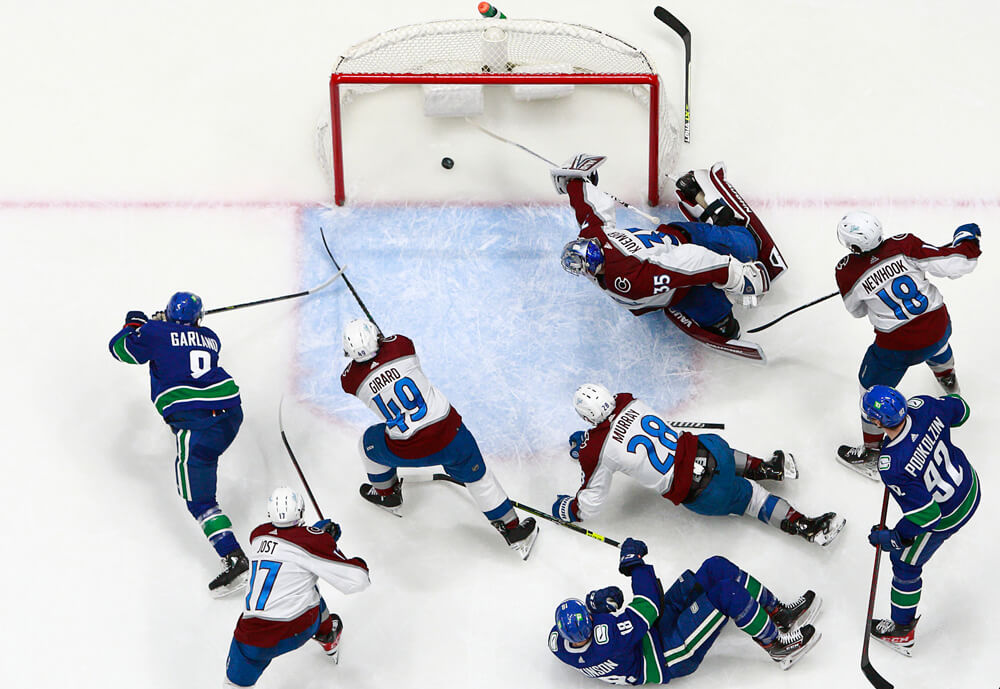
T
he first time Conor and Garry Garland sat in the turquoise seats of the Moncton Coliseum, peering out at the lattice of blue beams hanging above the ice, they were enthralled by the sight. It was December 2012 and the younger Garland had made the tough decision to forego a scholarship offer from Penn State University to head into unknown territory in the QMJHL. And here, taking in the first Canadian arena he’d call home, the impact of the decision hit him.
“This is different,” Garry said to his son as the two gazed out over the ice. “This looks like the NHL.” Garland remembers agreeing then, and he does still. “It was special,” he says. “I mean, I was 16. I was so young and it felt like you were in the NHL at the time. You’re playing in a big market, you’re playing juniors, you’re wearing a half-shield, you’re playing with some [future]NHL guys. … They used to have a huge [inflatable]wildcat, and you’d skate out of that. Just doing that, I remember thinking, ‘This is the best thing ever.’”
By the midpoint of his second year in the Q, Garland felt he’d figured the league out. The game slowed down, the patterns became predictable. A broken wrist delayed his breakout, but the winger came back in Year 3 and piled up 129 points in 67 games, tying for the CHL scoring lead and earning QMJHL MVP honours.
It hadn’t taken long during that campaign for Garland’s teammates to realize it was going to be a special year. “I think we kind of knew a month into the season,” Askew says. “The first month, he was playing unreal — point-per-game, doing his thing. But our captain got injured … [Conor] got bumped up to play with [Ivan] Barbashev. And them two, they went off.” Something seemed to just click between Garland and the eventual St. Louis Blues centreman, their instant chemistry the step that lifted Garland’s game to a whole new level. “It was just something special every night. It was a hat trick, six points. I mean, just putting our team on his back, really,” Askew remembers. “He got that spot on the top line and never let it go.”
The next year, he did it again, putting up 128 points to become the only player other than Crosby to ever lead the CHL in scoring more than once. For those who were there to see it happen, the catalyst for Garland’s dominance is no mystery. “He’s by far the most competitive player that I’ve ever coached,” says Darren Rumble, who was behind the bench for both of those breakout seasons. “He just had ‘compete’ ingrained in his DNA.” Askew and fellow Massachusetts native Zach Malatesta formed a tight bond with Garland during their time in Moncton, the trio connecting over a shared love of their home state by meeting up to watch “Boston movies” — The Town and Good Will Hunting among their favourites. But they knew if a win was in Garland’s sights — whether it was a casual game of ping-pong, a pre-game sewer-ball session or a battle on the ice — that friendship went out the window. “He’d never want to lose. Whether it’s practice, summer skates or a playoff game, it didn’t matter,” says Malatesta. “He just never gives up. His work ethic and skill, that combination — I just knew he had something special.”
When Garland finally moved on to the next level, though, he was viewed as anything but special. After being passed over in his first year of draft eligibility, the winger was finally tabbed with the 123rd-overall pick in the 2015 NHL Draft by Arizona. Earning his first shot as a pro in 2016 with their AHL affiliate, the Tucson Roadrunners, he arrived in the desert only to find himself buried on the fourth line. Not the step up he’d imagined after putting together one of the most dominant two-year runs in junior hockey history. “It was surprising,” Garland says. “I remember the first game in the American League, I had like two shifts in the first period. I remember sitting on the bench like, ‘This stinks.’ Like, ‘This is not what I’m used to, I don’t know what’s going on.’ I remember I just didn’t play a lot, and it went on forever, obviously — I probably played three to five minutes a night.”
By this point, he’d been hearing the comments from naysayers for a decade. And sitting on that bench, so close to his dream but still so very far from it, he began to wonder if the doubters were right. “You know, after 30 games, you have four points, you’re starting to think, ‘Do I stink? What’s going on? Why can’t I score?’” he says. “You used to hear, ‘Oh, he’s not a pro player, just a junior.’ So then I’m like, ‘Maybe everybody else was right.’”
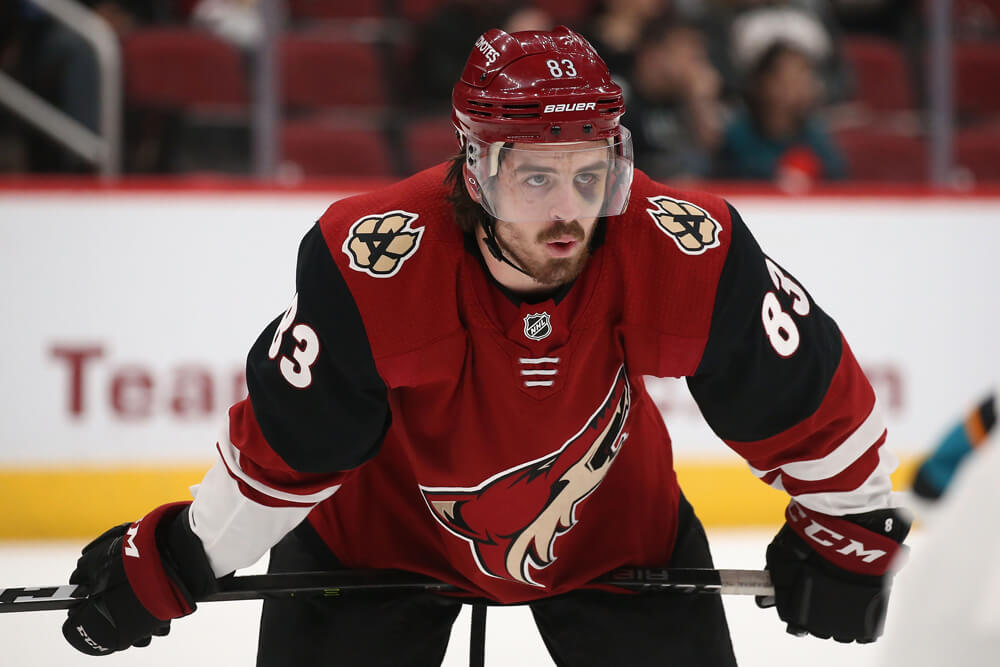
A coaching change after his rookie year helped him stave off those doubts. In came Mike Van Ryn to lead the bench, the former NHLer shifting the Roadrunners’ approach to utilize what they had throughout their lineup. When it came to Garland, the new coach made clear Year 2 was going to be different. He and his staff were going to develop Garland, he told the winger, give him his confidence back. They were going to turn him into a pro. “And they did,” Garland says. “That second year is kind of where my career changed.”
Slowly, the numbers started improving, bumping up in that second year and swelling the next, Garland scoring at more than a point-per-game pace by his third year in the AHL. That growth was the result of more than just a change in tactics or a spot on a new line. “I just think having someone believe in you is everything, you know?” says Garland. “You’re lucky at that point to get people like that to help you. And I just remember once I got my confidence back and started playing the way they taught me, then I was all set.”
His progress during that third year in the minors led to another milestone moment in early December 2018, when Garland got the call to make his NHL debut, brought up to face (who else?) the Sharks.
It went terribly, by Garland’s own assessment, the weight of the moment limiting his impact. “I waited my whole life for it,” he says of that first game. “You think you overthink something happening in a week — I overthought that thing for 25 years.” Unimpressive as it might’ve been, though, the debut performance was enough to earn a second game. And when the club headed back to Boston for that next tilt, back to friends and family who could calm his nerves, Garland managed to show what he could do, earning a chance to stick with the big club. “We all knew he’d be fine — all he needed was his chance in the NHL and he wasn’t going back down,” says Askew, who was watching proudly from afar. “That was his shot. He wasn’t going to let it go.”
It took time for Garland to settle in with the Coyotes. In the beginning, he kept to himself, focusing on trying to navigate life in the NHL. But as the months wore on, the same magnetism that seemed to draw people in wherever he’d played began pulling the club’s veterans closer. “You just saw guys gravitate to him, you know?” says Rick Tocchet, the Coyotes’ head coach at the time. “[Clayton] Keller, [Jakob] Chychrun, Phil Kessel, they were together constantly. And he was kind of the ringleader there.” The veterans dined out on their new rookie’s obsession with Boston, conversations quickly turning into debates about Tom Brady, or the Red Sox, or the Celtics. But it was what Garland did on the ice that truly endeared him to his new team.
“I mean, he scored a goal in Edmonton where there was a slapshot that went off his face into the net — and he scored another goal that game,” says Tocchet. “You know, he had cuts all over his face, and he’s interviewing with Hockey Night in Canada. I think that kind of took off, like, ‘Hey man, this guy’s not afraid.’”
After putting up 22 goals and 39 points in his first full NHL campaign, Garland followed up with another 39-point performance for the club last season, this time reaching the total in 19 fewer games. And much like everything else that’s come his way on the ice, it wasn’t just natural growth that brought that progress — it was Garland’s stubborn belief in his own potential, coupled with a willingness to invest the hours and sweat needed to reach it.
Tocchet remembers one particular conversation with the winger when he saw those gears turning. “We were at centre ice at the start of the year, and I said to him, ‘You’re not an 18-minute player in my eyes,’” the coach recalls of the moment, back when Garland was averaging around 14 minutes a night. “He looked me in the eyes, and he challenged me — he goes, ‘Well, make me an 18-minute player. Coach me into an 18-minute player.’” So Tocchet hit him with some hard truths. “I said, ‘You’re going to hear some stuff that you might not like. You’ve got to be more structured, you’ve got to play better defensive hockey. I love the fact that you’re an instinctual player, but you’ve also got to be a system guy, too, when you need to be.’ That was one thing that he took to heart. He worked on his game, watched video, worked on that hard in practice.
“The one thing he does is the next day, he shows up and he’s raring to go again. Even if he had a bad night or he didn’t agree with a coach or he didn’t like his game, the next day, he punches the clock again.”
By the end of his final year in Arizona, Garland’s average ice time sat at 17:55.
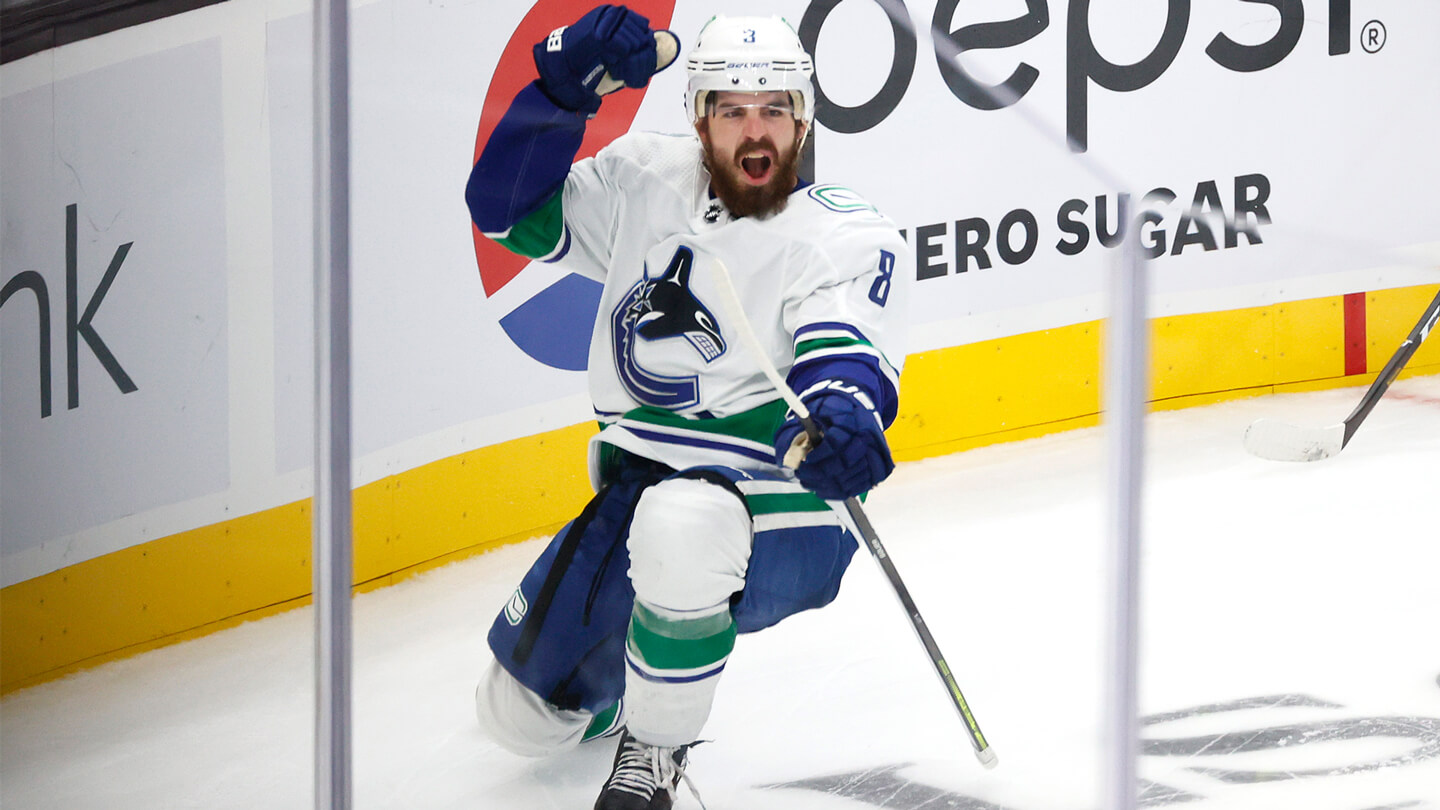
W
hether it was back in Boston as a kid, in the Q as a teenager, or as a pro in the desert, one thing’s always been true of Garland: when the lights get brighter, he gets better. “He’s the kind of person that lives for that spotlight,” says Malatesta. He and Askew got a front-row seat to that side of Garland’s game back in their Wildcats days, when The Garland Show tended to cause a ruckus with opposing crowds. “I mean, we played in some rinks that absolutely hated him. He just ate it up,” says Askew. “[He’d be] getting booed every time he touched the puck. You don’t boo a player who’s not a great player, who’s not special.”
Another wide smile breaks through Garland’s beard when he thinks back on those nights and the boos that rained down. “You know, you’re 18 and you think you know everything. I had 100 points a couple months into the season, so I was pretty confident in myself and my ability,” he says. “I used to get booed every time we’d play on the road — for me at that age, it was a lot of fun. I enjoyed that, and our team enjoyed it, and we played off it — we played really, really well on the road that year.
“Honestly, I was more excited for road games than the home games, because I knew I was getting booed, and it was almost an event for me.”
Coming off the thrill of those wild nights out east, Garland lost a bit of that joy when he moved on to the next level. Becoming an everyday NHLer was a dream come true, but on and off the ice, it was different. “Arizona was great, but it’s not a huge hockey market. They have great fans, but I remember a former player who said he never got recognized — and he was there, like, six years,” Garland says. “I didn’t get recognized really at all there. … I got recognized in Moncton way more than I did in Arizona.”
On a Friday in late July, he was thrown back into the spotlight when news broke that he and longtime teammate Oliver Ekman-Larsson were traded from the Coyotes to the Canucks, the winger signing a five-year, $24.75-million deal with his new club soon after. It was a bittersweet turning of the page, leaving the only NHL organization he’d ever known, but the move brought back a taste of what he’d had the last time he played for a team north of the border, when he was lighting up the opposition every night: the chaos of a Canadian market, the chance to play for a city where his sport is the main attraction, to witness the passion of a buzzing Rogers Arena if enough wins were strung together.
In the early going this season, the chaos has far outweighed any buzz in the arena. While Garland emerged as one of the few Canucks who played well early on — ranking among the team’s top scorers and doing what he could each night to drag them into the fight — the losses continued to pile up until a coaching change eventually slowed the fall. But those who know him best know this is precisely the fight Garland’s built for.
“[It’s] obviously a pressure cooker there, but I think he embraces that. He wants that,” says Tocchet. “He wants to be on the ice, 2–2 game with six minutes left and the pressure on him to make something happen. … I think he wants to meet it head on. ‘Get me out there. Let me have the puck in these situations — if I don’t produce, it’s on me.’ I think that’s his attitude, and I think that’s the attitude that you have to have when you go into those markets.”
Bigger picture, beyond helping to pull the Canucks out of this current hole, Garland’s hope is that Vancouver sees him make good on the potential he’s long seen in himself. Because in his eyes, he hasn’t yet come close. “I wouldn’t say I’m a star or I’ve had too much success,” he says. “I’m only 25. You know, I follow a lot of hockey history and [have tracked]the trajectory of some smaller guys that are like me, when they hit their peaks and when they do their best. And it seems like at my age, you just start coming into your own. Hopefully that’s the same with me.”
His former coaches mention one name in particular when discussions of Garland turn to what the latter stages of his career could look like: Martin St. Louis.
Rumble, Garland’s coach in Moncton, spent some time alongside St. Louis in Tampa Bay back in his own playing days, watching the winger emerge as a dominant force in his late 20s and early 30s. He sees, at the very least, a similar fire in both players. “Those guys have been told, ‘You can’t do it’ so many times in their life, they just have that ‘I’ll show you’ attitude,” he says.
Tocchet coached St. Louis for two of the Hall of Famer’s world-beating seasons with the Lightning. He saw firsthand what that attitude reaped. “I’m not going to put him in Marty St. Louis’ category right now, but Marty St. Louis, a small player with a huge heart that was just a dynamic player — a guy like that is someone that Conor can look towards,” Tocchet says. Though Garland’s a long way from St. Louis’ prolific scoring touch, it’s that fire, again, that connects them, says the coach: “Both were not afraid.”
As for touching the rest of St. Louis’ legacy, it’s a lofty goal. But ask those who know Garland best, and they’d caution against heaping too much doubt on his name. Donato’s been there since Garland’s earliest days on the ice. He’s skated with him over countless summers, discussed the winding path to the NHL with him, faced off against him in the big leagues. He knows better than most the promise of Garland’s potential, and the mistake of questioning how far he can push himself. “Conor’s earned everything he’s got,” Donato says. “At every level, he produced. And even though he was producing, he would never get the respect. … Now in pro, he’s still producing and doing those things, and there’s still people that doubt him. But I think that’s what drives Conor.”
Whether you doubt him or believe, know that Conor Garland will come back, time and time again. He’ll keep pushing and clawing and battling, as he always has — it’s just the way he’s wired, says Tocchet. It’s that, above all else, that stands out to the coach when he thinks back on their time together in Arizona. That fire. “A lot of times I remember, the last couple years, he was in the middle of things, in a scrum. They’re punching him in the head, he’s sticking in there, he’s yelling at them — and then he’s right back the next shift, right in that same area again,” Tocchet says. “It’s tough to go back in that area again, with those big defencemen — who wants to get hit in the face again, right? But I think it shows the other team, man, this guy’s not going away, you know?
“He’s not going to go away.”
Len Redkoles/NHLI via Getty Images; Roy K. Miller/Icon Sportswire via Getty Images; Jeff Vinnick/NHLI via Getty Images; Christian Petersen/Getty Images.


